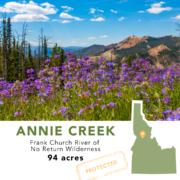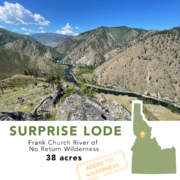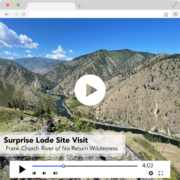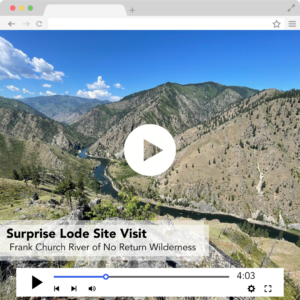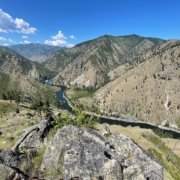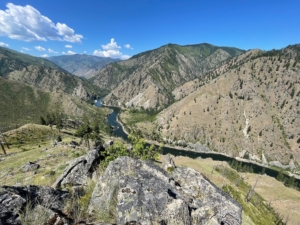August 11, 2023
This week The Wilderness Land Trust completed the transfer of the 38-acre Surprise Lode property, adding it to Idaho’s Frank Church River of No Return Wilderness. This project builds off the adjacent Painter Mine property we transferred in 2017.
Earlier this summer we visited the Surprise Lode property with our USFS partners in preparation for its transfer and addition to the wilderness. At the end of the visit, as we were headed back downriver, our jet boat captain handed me a photo book sealed in a ziplock bag. Inside were historic photos, many showing the inhabitants of the old homesteads and mines we’d passed along the river. The captain pointed to a photo of a Chinese woman beside a horse and said “That’s Polly, you’d like her. She was a neat lady and lived an amazing life out here”. Later, once I’d returned home to Montana, I found her story, along with the story of many others who made this incredible wilderness landscape their home.
The Salmon River Canyon has been inhabited for almost 10,000 years, first by the Old Cordilleran people in the late Pleistocene, then by their descendants the Nez Perce and Mountain Shoshone tribes. The river and surrounding wilderness remain an important cultural and spiritual homeland for the tribes. The first white men to travel the Salmon River were trappers and hunters in the 1830s, followed by gold miners in the 1860s. Travel by land through the Salmon River Canyon, which is deeper than the Grand Canyon, was very difficult. So miners would build and launch wooden scows upriver in the town of Salmon, then once they’d reached their downstream destination, disassemble their boats to build cabins. This gave this river its nickname as the “river of no return”.
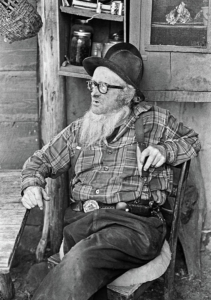
Buckskin Bill
As the gold rush boomed then busted, the Salmon River was home to some iconic characters. Some were expected like Buckskin Bill, known as the ‘last of the mountain men’ who made his home just downriver from the Surprise Lode property in the 1930s and built a stone gun tower, which still stands, above his cabin to “defend it” from the USFS seeking to protect the area.
Others, like Polly Bemis, were less expected. Standing at only 4’5”, Polly was born in northern China in 1853, where she was sold into slavery and brought to San Francisco, then Warren, Idaho where, at the age of 19, she was sold to a saloon owner. It’s unclear how Polly gained her freedom, but by the 1880 census she was listed as living with her friend Charlie Bemis, who had looked out for her since her arrival in Warren. Once free, Polly was financially independent, taking in laundry and building and running her own boarding house. Charlie and Polly later married, and in 1894 they moved to a remote homestead on the Salmon River where they staked a mining claim.
For much of her life, Polly’s story was written by others— she was enslaved, taken from her home, and almost certainly endured the intense discrimination that Chinese Americans faced on the frontier. Even decades after her freedom, a rumor that she had been won in a poker game still persisted, despite her insistence it wasn’t true. But on the banks of the Salmon, she was able to write her own story. Along with Charlie, she made her home, keeping a garden and caring for a number of animals including horses and a cougar. She was known and admired by homesteaders and miners throughout the area for her nursing skills, as an expert angler, and for her toughness, friendliness, wit, and sense of humor. She was known for who she was- for her kindness, skills, and talents- not as property or a trite stereotype.
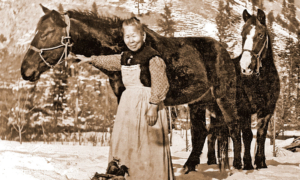
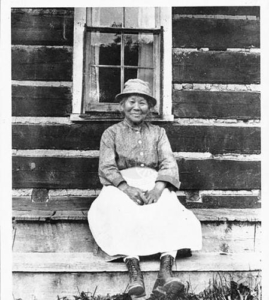
In 1922 their cabin burnt down and a few months later Charlie died, likely of tuberculosis. After rebuilding her cabin with the help of her neighbors, Polly went on living by herself in the rugged wilderness until her death in 1933 at the age of 80. Since then Polly has become something of an icon, with a book Thousand Pieces of Gold based on her life, her restored cabin on the National Register of Historic Places, and her induction into the Idaho Hall of Fame.
Polly’s story struck me, both as a welcome diversion from the typical mountain man archetype, as well as a portrait of the freedom and sense of self that she, and many after her, found in the wilderness. For so many of us, our relationship with wilderness is shaped by the freedom we feel in it, the community that it connects us to, and the self-discovery that comes from solitude and hard days on its trails. Polly’s story reminds us that wilderness is for everyone, not just those you’d expect to find in it. And it reminds us how important it is to protect wilderness so that future generations have the opportunity to find their way in the world through it, just as she did.
A few miles upriver from where Polly is buried, we’re proud to be adding 38 acres to the wilderness she loved.
– Margosia Jadkowski, Director of Marketing & Communications

